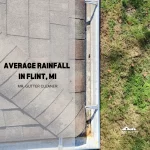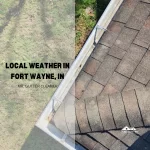In Indianapolis, various tree species significantly influence home maintenance, particularly gutter cleaning. These trees, shedding leaves and seed pods, often lead to gutter blockages, demanding regular maintenance.
Understanding the seasonal behaviors of these trees is crucial for homeowners to schedule gutter cleaning effectively.
Neglecting gutters can result in severe home maintenance issues, emphasizing the importance of being aware of the tree types around one’s property.
Implementing preventive measures, such as gutter guards, can mitigate the risk of blockages.
Homeowners face a choice between professional services and DIY approaches for gutter cleaning.
Considering the types of trees, their shedding patterns, and the potential impact on gutters, proactive and regular maintenance becomes a vital aspect of home care in Indianapolis.
This awareness aids in preventing long-term damage to home infrastructure, ensuring the longevity and safety of the property.
What Types of Trees are Most Common in Indianapolis?
Indianapolis is home to a variety of trees, each contributing uniquely to the local ecosystem and home maintenance challenges. Key among these are Maple, Oak, and Elm trees. Maples, prevalent in urban and suburban landscapes, shed leaves extensively in the fall. Oaks, known for their hardy nature, drop acorns and leaves, often creating substantial gutter debris. Elms, with their dense foliage, contribute significantly to leaf accumulation in gutters.
Table of Contents:
- What Types of Trees are Most Common in Indianapolis?
- Why is Gutter Maintenance Crucial in Homes Near Trees?
- Identifying Trees That Shed Leaves and Seed Pods
- The Importance of Regular Gutter Cleaning in Indianapolis
- Preventive Measures for Gutter Blockage Due to Tree Debris
- Impact of Neglected Gutters on Home Maintenance
How Do These Trees Impact Home Maintenance?
The presence of these trees near homes necessitates regular gutter cleaning. Maple leaves, for instance, can quickly clog gutters and downspouts, impeding proper water drainage. Oak leaves and acorns add to this problem, while their size and quantity can lead to gutter sagging if not cleared. Elm leaves, being smaller, may seem less troublesome, but they accumulate rapidly, especially during fall, demanding more frequent gutter maintenance.
Seasonal Changes and Tree Behavior in Indianapolis
Seasonal changes in Indianapolis greatly affect tree behavior, influencing home maintenance routines. Spring and fall are particularly critical times for gutter cleaning. In spring, seedlings from trees like Maples and Elms can clog gutters, while in fall, the leaf drop from these species is at its peak. Understanding these seasonal patterns is vital for homeowners to plan gutter maintenance effectively, ensuring their home’s protection against water damage and structural issues.
Why is Gutter Maintenance Crucial in Homes Near Trees?
Gutter maintenance is vital in homes surrounded by trees primarily due to the debris these trees shed. Leaves, twigs, and seed pods can accumulate in gutters, causing blockages that impede water flow. This obstruction can lead to water damage to the roof, siding, and foundation of the home. Regular gutter cleaning removes this debris, ensuring proper water drainage and protecting the home’s structural integrity.
Understanding the Connection Between Trees and Gutter Blockages
The proximity of trees to a home directly correlates with the frequency of gutter blockages. Trees like Maples, Oaks, and Elms, common in Indianapolis, shed materials that easily clog gutters. For example, Maple leaves, being broad and plentiful, can quickly fill gutters, while Oak acorns can create significant blockages, necessitating their regular removal to prevent water overflow and potential damage to the home.
Seasonal Gutter Cleaning: When is it Most Needed?
Seasonal gutter cleaning is crucial, particularly in fall and spring. Fall sees an increased shedding of leaves and seed pods, leading to gutters being filled more rapidly. Spring, on the other hand, presents issues with seedlings and blossoms, which can also clog gutters. Timely cleaning in these seasons is essential to prevent water buildup and to mitigate the risk of water damage to the home’s foundation and exterior.
Identifying Trees That Shed Leaves and Seed Pods
In Indianapolis, identifying trees that shed significant amounts of leaves and seed pods is crucial for effective gutter maintenance. Trees such as Maples, Oaks, and Elms are particularly known for their abundant leaf and seed pod shedding. These trees, while enhancing the city’s beauty, pose challenges for homeowners in keeping gutters clean and functional.
Common Leaf-Shedding Trees in Indianapolis
Among the most common leaf-shedding trees in Indianapolis are Maples, with their broad leaves creating substantial gutter debris in the fall. Oaks, while valued for their sturdiness, shed both leaves and acorns, contributing to gutter blockages. Elms, with their smaller, yet plentiful leaves, also contribute significantly to the accumulation of debris in gutters.
Types of Seed Pods and Their Impact on Gutters
Apart from leaves, certain trees in Indianapolis produce seed pods that can clog gutters. For example, the Sweetgum tree drops spiky seed pods, which can lodge in gutters and downspouts, causing blockages. Understanding the types of trees and their respective debris is vital for homeowners to anticipate and manage the impact on their gutter systems effectively. Regular gutter cleaning and maintenance become essential practices to prevent these natural elements from causing damage to the home’s exterior and foundation.
The Importance of Regular Gutter Cleaning in Indianapolis
Regular gutter cleaning in Indianapolis is crucial, particularly in areas with abundant tree coverage. Gutters clogged with leaves, seed pods, and debris from common trees like Maples, Oaks, and Elms can lead to serious home maintenance issues. Ensuring gutters are free from obstructions is key to preventing water damage and maintaining the integrity of a home’s foundation and exterior.
How Tree Debris Affects Gutters and Drainage
Tree debris, primarily leaves and seed pods, can accumulate quickly in gutters. This accumulation impedes water flow, leading to overflow and potential water infiltration into the home’s structure. In winter, blocked gutters can cause ice dams, further endangering the roof’s integrity. Regular cleaning ensures gutters function properly, directing water away from the home and safeguarding against these risks.
Best Practices for Gutter Maintenance in Tree-Dense Areas
For homeowners in tree-dense areas of Indianapolis, adopting best practices for gutter maintenance is essential. This includes regular inspections, particularly after storms or during fall when leaf shedding is at its peak. Cleaning gutters at least twice a year, in spring and fall, is recommended to prevent buildup. Additionally, considering professional gutter cleaning services can provide thorough cleaning and inspection, ensuring all aspects of the gutter system are functioning optimally.
Preventive Measures for Gutter Blockage Due to Tree Debris
Implementing preventive measures for gutter blockage is essential, especially in areas like Indianapolis with common trees known for shedding leaves and seed pods. These measures not only ease the burden of regular gutter maintenance but also prolong the lifespan of the gutter system, ensuring optimal functionality.
Gutter Guards and Other Preventive Solutions
One effective preventive measure is the installation of gutter guards. These guards are designed to keep leaves, twigs, and seed pods out while allowing water to flow freely. Various types are available, including mesh screens and foam filters, each suited to different types of debris. Selecting the right gutter guard depends on the types of trees surrounding the property and the nature of the debris they produce. Regular inspection and cleaning of these guards are also necessary to maintain their effectiveness.
Professional vs. DIY Gutter Cleaning Approaches
Homeowners must decide between professional gutter cleaning services and DIY methods. Professional services offer comprehensive cleaning and can identify and address potential issues, such as leaks or damage, which may not be easily noticeable. On the other hand, DIY approaches can be cost-effective and allow homeowners to inspect their gutters regularly. However, they require the right tools and safety measures, especially for high gutters. Regardless of the chosen method, the key is consistency in maintenance to prevent blockages and associated damage.
Impact of Neglected Gutters on Home Maintenance
Neglecting gutter maintenance in homes, especially those near common trees in Indianapolis, can have severe repercussions on home maintenance. Gutters clogged with leaves, seed pods, and other tree debris can lead to a series of problems, affecting the home’s structural integrity and overall safety.
Potential Damage from Clogged Gutters
Clogged gutters can cause water overflow, leading to significant damage to the home’s roof, siding, and foundation. The excess moisture can create an ideal environment for mold and mildew growth, which poses health risks and can deteriorate building materials. In winter, blocked gutters can contribute to the formation of ice dams, which can damage the roof and lead to costly repairs. The weight of debris and standing water can also cause gutters to sag or detach, compromising the home’s exterior and potentially leading to expensive gutter replacement.
Long-term Effects on Home Infrastructure
The long-term effects of neglected gutters extend beyond immediate repairs. Consistently blocked gutters can lead to chronic moisture problems, weakening the home’s foundation and potentially causing basement flooding. Over time, this moisture can erode landscaping and cause soil erosion around the home, further destabilizing the foundation. Regular gutter maintenance is not just a task for preserving the home’s appearance; it is a critical measure for safeguarding the home’s structural health and longevity.


